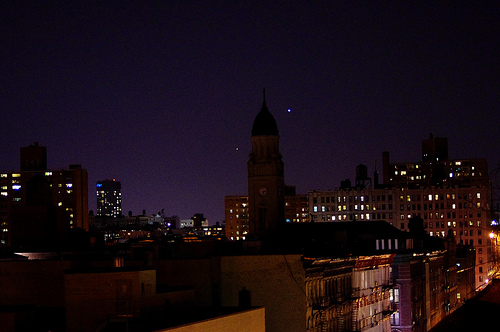
Planetary Conjunction Of Venus And Jupiter March 2012
March 20. March Equinox. The March equinox occurs at 05:14 UTC. The Sun will shine directly on the equator and there will be nearly equal amounts of day and night throughout the world.
It’s springtime, or just a few hours away from it officially, and if you look to your western sky right after dusk (the best viewing time is approximately around 10:00 PM EST), you’ll see Venus and Jupiter. Venus is on the top right and Jupiter is just below on the left, what is referred to as conjunction. This is astronomy in the northern hemisphere.
If you want to see something spectacular, be sure not to miss Venus and Jupiter in the west. They both look extremely large and magnificent. I’m not sure how long they’ll be hanging around so you better view them soon. Remember, just after dusk. (Observation inserted here: Both planets seemed to have vanished into the horizon later on in the night.)
For an added bonus, Pleaides is just above Venus, slightly to the left. Pleaides is a very prominent star cluster located in the constellation of Taurus. See if you can spot this gem!
If you look to the east, you can also see Mars and Saturn, although you might have to wait a few hours into the night to see the latter.
Orion is very visible and can be spotted in the southwestern region of the sky. Orion contains three stars that are placed horizontally; they are Orion’s belt.
Sky & Telescope magazine is considered to be one of the best in the astronomy field. Personally, I have not subscribed to this magazine, but it looks like a good one.
I do get on the Sky & Telescope website and it’s quite helpful if you’re a star gazer. Star gazing tips can always be found here.
Happy star gazing!
Image Credit:
Shankbone 4
Subscribe Now!
Featured Deal ➸
Social Button ➸
Categories
- ! Без рубрики
- 1
- 7Slots
- a16z generative ai
- Amateur Radio
- antikaeltehilfe.de
- bauhutte-g.com
- blog
- Casino
- chefi.gr
- Cryptocurrency exchange
- extension-autoroutes-non.ch
- Forex Trading
- Future Tech
- Geeky Tips
- Going Green
- Going Mobile
- hundemesse-norderstedt.de
- kinbet-casino.at
- kinbet.at
- mireillelebel.de
- News
- Pin-Up AZ
- Pin-Up indir
- Pin-Up oyunu
- Pin-UP VCH
- Post
- Product Reviews
- ready_text
- s
- s1
- Scanner Listening
- Science Sightings
- Sober living
- Technology
- thomas-petandfamily.de
- Uncategorized
- Новости Форекс
Archives
SQUIDBOARD
Academic Tech
Multimedia MegloMania
Tech Toolbox
- Acronis
- AN/GRC-9
- Apple Final Cut Pro
- Audacity
- Audacity VST Plug-ins
- BleachBit
- ClimateViewer 3D
- Cool Edit Pro 3.1
- CyberGhost
- Flickr
- FreeSCAN
- fring
- Fruper
- FTA Lists
- GPS Calculator
- GPS Converter
- HAMSOFT
- HF Antennas
- inSSIDer
- Levelator
- MaxMind
- Microphone Cables
- Morse Code Chart
- Old Version
- Pendriveapps.com
- PortableApps.com
- Privacy Badger
- PulseAudio
- Rowetel
- ShopJimmy
- Teleprompter Software
- TV Listings
- UNetbootin
- Voicemeeter Banana
- Winlink
Navigate the Night Sky like Galileo ➸
Popular Squids ➸
Poll ➸
Recent Posts
- Mostbet зеркало рабочее – Вход на официальный сайт Мостбет.3276
- Chicken Road – Slot di casin online per giocatori che amano vedere le galline attraversare la strada.321
- Mostbet букмекерская контора и казино онлайн Мостбет.9432
- Mostbet зеркало рабочее – Вход на официальный сайт Мостбет.2520
- Mostbet зеркало рабочее – Вход на официальный сайт Мостбет.3818
RSS feed for comments on this post · TrackBack URI
Leave a reply